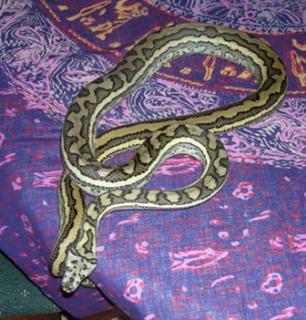Python - Queensland Carpet
Scientific Name: Morelia spilota mcdowelli
Sat, 19th April, 2025 - 5:57 am GMT
Sponsor Ads:

Alternative Name
Scientific Name: Morelia spilota mcdowelliBasic Info
The Queensland Carpet Python is one of the largest of the Carpet Pythons, generally averaging between 72 and 90 inches in length. Some Queensland Carpet Pythons have been recorded at lengths over 14 feet. They have a medium girth, relative to other pythons, and have very large heads. The beautiful pattern on the Queensland Carpet Python's skin is paler on the bottom than on top and is made up of markings of olive-green, brown, olive-brown, bronze, red-brown, terra cotta, tan, cream and light brown. The pattern often manifests as dumbbell shaped blotches that run down the snake's body. The blotches can also be oval shaped. Often, the blotches join. More than one pattern may be present on any snake.
Health
Because Queensland Carpet Pythons are semi-arboreal, they should be kept in a tall enclosure with plenty of sturdy branches for climbing. The temperature within the cage should be between 80 and 85 degrees Fahrenheit, with a basking area of about 95 degrees. At night, the temperature should drop to between 70 and 75 degrees. Unless the animals are to be bred, they do not need to undergo brumation in the winter. Breeding Many breeders use multiple males to breed Queensland Carpet Pythons. If this technique is used, they should be carefully observed so the snakes do not hurt each other. The two males and the female should be allowed to interact for a while, after which the extra male should be removed. If all goes well, the remaining male and the female will copulate at that time. Placing the skin of another male in the tank with the breeding pair can have the same effect. Prior to breeding, the Queensland Carpet Pythons should undergo a period of brumation. Usually in late October, the temperature in the hot region of the tank is gradually decreased about five or ten degrees. The temperature should remain low for between 8 and 12 weeks, after which it should be gradually increased to normal. Once the temperature has been increased, the animals should be left together until spring, being separated once every week to feed. During the breeding season, males often refuse to eat. About 20 days after ovulation, the female will shed. She will lay her eggs around 25 days after shedding, and the eggs will hatch between 49 and 64 days of incubation at about 86 degrees Fahrenheit.Habitat
They can generally be found in regions along the coast that are very densely forested.Behavior
The Queensland Carpet Python is also known as the Coastal Carpet Python. It is native to Australia and is an excellent choice for someone who wants a somewhat large, yet easy to care for snake. Queensland Carpet Pythons are generally docile and make excellent pets. A semi-arboreal snake, the Queensland Carpet Python spends much of its time in the wild in trees or bushes.Male Carpet Pythons may be aggressive towards each other, especially during breeding season.Origin
AustraliaHistory
The Queensland Carpet Python can be found along the eastern coast of Australia. They appear throughout Queensland and venture as far south as New South Wales, generally considered Diamond Python territory. They are found in the same area as the Jungle Carpet Python, and it is believed that the two subspecies interbreed. The patterns found on the Queensland Carpet Python vary depending on the region in which it lives, and it is believed most Queensland Carpet Pythons in captivity come from the area north of Townsville in Queensland. Most Queensland Carpet Pythons available to the pet trade today are captive bred, and have been for the last twenty years. Because they are easy to care for and are generally docile animals, the Queensland Carpet Python can make an excellent pet for a beginner or an advanced hobbyist.Common Foods
Adult Queensland Carpet Pythons feed on possums, bats, rats, and bandicoots. The younger snakes generally eat lizards and mice.Sponsor Ads:
No one can make you feel inferior without your consent. -- Unknown
Python - Queensland Carpet
Coded by: BGID® | ALL RIGHTS RESERVED Copyright © 2000-2025
Disclaimer | Privacy | Report Errors / Contact | Credits








 Why haven't we as a collective earth met with aliens yet?
Why haven't we as a collective earth met with aliens yet?  The Best Text Adventure You Will Ever Play! The official site:
The Best Text Adventure You Will Ever Play! The official site:  Homosexual behavior stems from the mind or genetics?
Homosexual behavior stems from the mind or genetics?  World EcoSystem - Biodiversity Changes - Who is on board and who isn
World EcoSystem - Biodiversity Changes - Who is on board and who isn  Mouthwash - Mouthrinse - Mouth Sores - Healing Infections - Gingivitis
Mouthwash - Mouthrinse - Mouth Sores - Healing Infections - Gingivitis  Treatment for Depression
Treatment for Depression  Ultra radical and violent Islamist group that even rivals Al Qaeda
Ultra radical and violent Islamist group that even rivals Al Qaeda  An idea to have teachers who want to carry guns to school undergo some level of police training will be left up to local school districts and police departments.
An idea to have teachers who want to carry guns to school undergo some level of police training will be left up to local school districts and police departments.